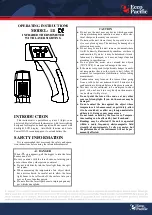
TEC2104-3 N2 Networked Multi-Stage Economizer Thermostat Installation Instructions
6
The Controller Point Type is the fixed-point definition
inside the controller. The BAS Model Point type is the
definition inside the model file. Use an NCM Control
System object to retrieve the data.
The most recent N2 command received by any of the
N2 Bus Objects listed in Table 1 controls the
thermostat.
If an Analog Data (AD) object is overridden by the
Metasys system, all local changes attempted through
the thermostat keypad for that AD object are ignored
until the override is released. For example, if the
Metasys system sends a write command to turn
System Mode Off, and then the occupant selects
System Mode On at the TEC keypad, the TEC ends up
with the System Mode On; however, if the Metasys
system sends an override command to turn System
Mode Off, and then the occupant selects System Mode
On at the TEC keypad, the TEC keeps the System
Mode Off.
Once an override is released, the AD object may once
again be changed through the thermostat keypad, but
the thermostat does not retain any data entered at the
TEC keypad during the override.
•
The value for Heating SP (ADI-3) and Setback
Heating SP (ADI-5) must stay within the limits
established in the controller by Minimum Heat SP
(ADI-7 read-only) and Maximum Heat SP (ADI-8).
•
The value for Cooling SP (ADI-4) and Setback
Cooling SP (ADI-6) must stay within the limits
established in the controller by Minimum Cool SP
(ADI-9) and Maximum Cool SP (ADI-10 read-only).
If a setpoint is overridden, the TEC, if necessary,
adjusts the other setpoint to maintain the minimum
deadband between the setpoints. The setpoints can be
spread further apart but can never be adjusted closer
than the current minimum deadband value.
Failure to stay within the limits for a command results in
an N2 Negative Acknowledge (NAK) error from the
TEC2104-3 thermostat.
Overrides take precedence over any local adjustment
or command in the TEC2104-3 thermostat.
You must not have a Relinquish Default for the
setpoints if you want to change them from the
thermostat display.
If there is a Relinquish Default for the setpoints, the
Network Automation Engine (NAE) always has an
Override for either an adjusted value or the Relinquish
Default Value. You should use Operator Override and
Release Operator Override if you want to command the
setpoint and release it to local control.
Once all the NAE commands are released, the
Override Status in the Hardware tab should be False.
At that time, the user should be able to change the
setpoint from the local display.
All overrides are released automatically after
10 minutes of no communications (for example,
network cable is removed from the TEC, causing loss
of network communications).
Temp Alarm
BI-2
N2 BI
CSBI
0 = Normal
1 = Alarm
BI-3
N2 BI
CSBI
0 = Off
1 = On
1.
Commandable.
2.
If one setpoint is overridden, the other setpoint may be automatically overridden by the TEC2104-3 thermostat to maintain
the minimum deadband between the two setpoints.
3.
The Multiple Command Output (MCO) object is used to schedule multiple Multi-State Objects (MSOs).
4.
When defining the N2 MSO, select TEC Mode from the States Text Menu. Type 4 for the TEC2104-3 thermostat.
5.
On the Metasys Network Command Module (NCM) system, map BD-9
Temp Units Mode
as a Binary Output (BO) object
with Auto Restore and Local Control set.
6.
Can be a Change-of-State (COS) alarm to the BAS or N2 Dialer Module (NDM) to initiate a dial-out.
7.
The state of DI1 and DI2 is communicated over the N2 network even if the digital inputs are configured as
None
through
the local interface at the thermostat.
Table 1: N2 Bus Objects (Part 2 of 2)
Point Name
TEC Point
Type/Address
N30/NAE
Object Type
BAS Model
Point Type
Override Range


































